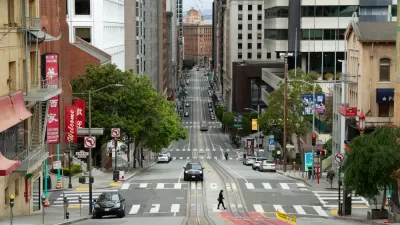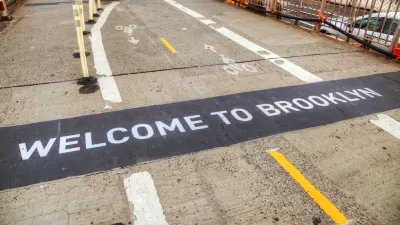The most recent bicycle counts from two of America's most progressive cities, New York City and Portland, have been made public. The results are impressive as much as they are instructive.
The most recent bicycle counts from two of America's most progressive cities, New York City and Portland, have been made public. The results are impressive as much as they are instructive.
With a 35% increase in measured bicycle trips, New York City has effectively doubled bicycle ridership in six years. Several socio-economic and cultural factors may be spurring Gotham's ascension as the east coast's most bicycle-friendly city: High gas prices, increasingly crowded subway cars and buses and environmental concerns. Not to mention a growing culture of velophiles interested in convenience, staying fit, cycle cool and simply having an enhanced connection to the city in which they live.
Yet the continued rise in ridership would not be occuring without the City's commitment to expanding its bicycle infrastructure. Bicyclists need to feel safe through an easily identifiable and connected bikeway system. By adding hundreds of miles of bicycle lanes, New York City is doing exactly that.
For personal reasons, I now visit New York City every month and am increasingly impressed by the growing number of bicycle lanes, sharrows, bicycle boxes and the City's general 'complete streets' approach towards some of their more hostile thoroughfares. The redesign of the Broadway, Fifth Avenue and Madison Square area provides an excellent example, as a former auto sewers now accomodates bicyclists safely and encourages people to linger within new plazas. For this, the work of NYC's DOT is nothing short of revolutionary. Streetsblog, one of New York City's leaders in the Livable Streets movment has even deemed the NYC DOT the most progressive public agency in the country. To learn more about the their initiatives, watch this recent Streetfilms interview with New York City DOT Commissioner, Janette Sadik-Khan. Beautiful work.
To be sure, bicycle parking remains unnecessarily difficult, and bicycling still comprises less than 1% of commuter mode share. However, the city is quickly adapting itself to the requirements of the 21st century. Keep at it NYC!
As for Portland, their reign as America's most bicycle-friendly big city continues. Unlike New York City, Portland has been investing in their bicycle infrastructure for decades.The result being that Portland is one of two Platinum rated bicycle-friendly cities, as determined by the League of American Bicyclists.
This year Portlanders can be proud because they are bicycling 28% more than they were in 2007, according to Bike Portland. Bicycle mode split is now at 8%. A far cry from the near 40% split in Amsterdam and Copenhagen, but impressive nonetheless.
Perhaps what is most interesting is how Portlanders bicycle. Jennifer Dill's latest research demonstrates that 51% of bicycle trips are taken on the 8% of city streets that contain some type of bicycle infrastructure (Lanes, Sharrows and bicycle boulevards). If 8% of streets can get 8% of the population bicycling, then we can likely expect a commensurate rise in the years to come as Portland continues to implement its bicycle master plan.
In short, a clear relationship exists between the expansion of bikeway infrastructure, daily ridership and safety. As demand rises, American cities are doing more to accomodate this squeaky clean mode of transport. In turn, more people are bicycling while bicycle related injuries are not rising proportionately--a so-called 'virtuous cycle.'
The question remains, however, will it last?
Picking up David Herlihy's Bicycle:The History will inform you that bicycling in America has historically been a boom and bust phenomenon. History notwithstanding, the confluence of many interconnected environmental, social and economic realities could mean that this current trend could hold, especially since some American cities have never before provided so much bicycle specific infrastructure. Moreover, the American love affair with automobility may be coming to a close as even our three largest auto companies struggle to adapt their mid-20th century business models to a 21st century world. Of course, cars are not going to disappear from our streets. But did you know that bicycle sales have never been higher?! See this article from the Economist, which demonstrates bicycle sales far exceed automobile sales.
In the end, there is not a cheaper, faster or more pleasant way to experience a city. I say if you are willing and able, trade four wheels for two.

Manufactured Crisis: Losing the Nation’s Largest Source of Unsubsidized Affordable Housing
Manufactured housing communities have long been an affordable housing option for millions of people living in the U.S., but that affordability is disappearing rapidly. How did we get here?

Americans May Be Stuck — But Why?
Americans are moving a lot less than they once did, and that is a problem. While Yoni Applebaum, in his highly-publicized article Stuck, gets the reasons badly wrong, it's still important to ask: why are we moving so much less than before?

Using Old Oil and Gas Wells for Green Energy Storage
Penn State researchers have found that repurposing abandoned oil and gas wells for geothermal-assisted compressed-air energy storage can boost efficiency, reduce environmental risks, and support clean energy and job transitions.

Updating LA’s Tree Rules Could Bring More Shade to Underserved Neighborhoods
A new USC study finds that relaxing Los Angeles’ outdated tree planting guidelines could significantly expand urban tree canopy and reduce shade disparities in lower-income neighborhoods, though infrastructure investments are also needed.

California's Canal Solar Projects Aim to Conserve Resources and Expand Clean Energy
California’s Project Nexus has begun generating electricity from solar panels installed over irrigation canals, with researchers and state agencies exploring statewide expansion to conserve water and boost clean energy production.

HHS Staff Cuts Gut Energy Assistance Program
The full staff of a federal program that distributes heating and cooling assistance for low-income families was laid off, jeopardizing the program’s operations.
Urban Design for Planners 1: Software Tools
This six-course series explores essential urban design concepts using open source software and equips planners with the tools they need to participate fully in the urban design process.
Planning for Universal Design
Learn the tools for implementing Universal Design in planning regulations.
Heyer Gruel & Associates PA
City of Moreno Valley
Institute for Housing and Urban Development Studies (IHS)
City of Grandview
Harvard GSD Executive Education
Salt Lake City
NYU Wagner Graduate School of Public Service
City of Cambridge, Maryland





























